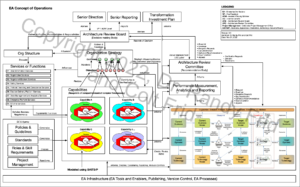Click here to see a full scale model of the EA Concept of Operations (CONOPS)
The ultimate outcome of Enterprise Architecture (EA) is to provide both a discipline and a program that delivers a graphical point-in-time blueprint of an organization (which is constructed over time) to to act as the baseline for any transformation, which in turn increases management’s Decision Advantage. EA provides a “graphical” view of an organization’s strategies, structures, behaviours, relationships, processes, information, technologies, security, privacy and policies.
If you DON’T utilize an architecture across your organizations, then you only have three approaches to any complex transformation:
- Tear it down and start from scratch – Virtually impossible in any operational organization. Not many large organizations can afford to stop everything, discard everything, then start again from the ground up.
- Trial and Error – Extremely high risk. The chance of something going seriously wrong when you need to guess what and how to change anything in a complex system is almost guaranteed.
- Re-engineer – Extremely expensive. Requires that you disassemble everything, measure everything, then create all new architectural models models and specifications before you can plan a transformation.
So the rationale “for” Enterprise Architecture is obvious. For thousands of years mankind has used architecture to design and transform complex objects and systems. Today’s organizations are some of the most complex systems ever created by man. There is more need for architecture today than at any point in history.
- Strategically, EA helps align desired outcomes to objectives, and objectives to capabilities, as well as helping to identify gaps or deficiencies in any planning effort.
- Operationally, EA then deconstructs each capability (like cracking open an egg) into it’s constituent parts (people, process, info, apps, tech, security) so you can see what all the parts are and how they interrelate.
- Tactically, EA is then used to graphically describe the current state vs any potential desired future state so the deltas and the options can be analyzed, costed and evaluated.
Overall, EA increases Decision Advantage when planning any transformation and investment. The results of EA efforts are then mapped into a graphical EA roadmap. By adopting, mandating, and enforcing the use of a formal EA program, management not only generates persistent, point-in-time (past, present, and future) models of their organization, they also receive the added bonus and rigour of traceability, auditability and compliance.
Note: Some large organizations also expand the EA Program to include a Technology Forecast to produce graphical Outlook Reports that analyze potential opportunities or disruptions on the near, mid and long-term horizons to inform decision-makers.
Authors: Dr. Randy Frid and Colt Frid

Dr. Randy Frid

